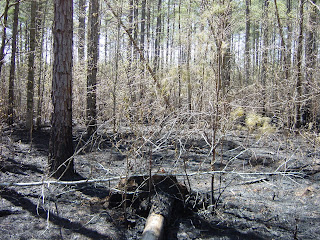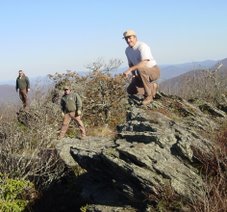We also occasionally get to do some pine understory burning, which is what we conducted this past week. This burn was done on about 25 acres of a mature loblolly pine stand. Since this was an understory burn, we did not want the fire "hot". This meant that the firing technique we used was a backing fire.
 Backing fires are lit on the upwind side of the burn and the wind is used to force the fire to slowly "back" thru the burning block. Occasionally, some "stripping" is/was needed to help the fire along. On this particular burn, we dropped some "spot fires".
Backing fires are lit on the upwind side of the burn and the wind is used to force the fire to slowly "back" thru the burning block. Occasionally, some "stripping" is/was needed to help the fire along. On this particular burn, we dropped some "spot fires".

Also, since we did not want the fire to burn very hot, we began the prescribed burn later in the evening as the humidity was going back up. This helped us to attain the results we were looking for and also meant that the burn would go on into the night.

Here is a video of the fire backing it's way thru the stand.
We would like to thank the Morganton wildlife management crew (pictured here is Chip, Jason, and Brian) for their willingness to assist us with this burn!

The burn did last into the night. Night burning allows us to see exactly how the fire, and more importantly, the ash and embers react to the wind.
 It is amazing to actually see the "ash" that you can't see in the daytime.
It is amazing to actually see the "ash" that you can't see in the daytime. Here, Mike and the Mule ATV are illuminated.
Here, Mike and the Mule ATV are illuminated.
Photo Plots
Photo plots are used to help us see the progression of the burning cycles. Photos will be taken over a period of time to see the effects of the fire on the understory in this particular case. Here are a few examples of some photo plots before and two days after the burn.




We will take other photos in the future to see the changes over time. It's only been a couple of weeks since the burn and it already looks differently in the burning block.
This burn concluded our prescribed fire season for this year. Now it's time to begin planting!

1 comment:
What part of backing fire does Jim not understand!!!
Post a Comment